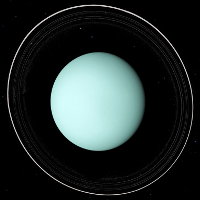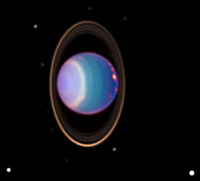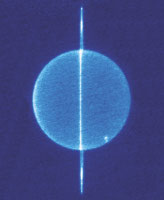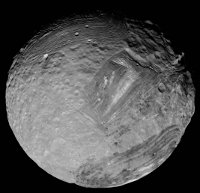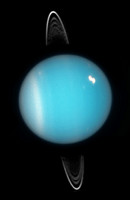New Planet
In 1781, William Herschel was doing a star survey with a home-made telescope, when he stumbled across a tiny bluish-green disk. When he returned to it several nights later, he could tell that it had moved. Soon, he became famous around the world for discovering a new planet. He was not actually the first person to see it though: Uranus is just bright enough to be seen by the unaided eye in good conditions. It had actually been marked on several star charts before the telescope was invented! Nobody noticed that it was moving because it crept along so slowly.
Ices
Uranus is made up of ices: frozen water, methane, and ammonia. They form a slushy fluid under a thick hydrogen and helium atmosphere. There is probably a small, rocky core, but no surface other than that. Some scientists consider it a gas giant, while others call it an ice giant (along with Neptune).
Tilt
Uranus is tilted about 90 degrees, and rotates on its side compared to the rest of the planets. That gives it very odd seasons, which are not well understood. We can see the largest clouds from Earth, but it's not enough to get a good idea of what is going on. We have only sent one spacecraft that direction, and when it flew by, the atmosphere was very smooth and quiet.
Moons
There are 27 known moons orbiting Uranus. Five of them are larger than the others, and are considered major moons. For historical reasons, the moons are named after characters from the works of Shakespeare and Alexander Pope, instead of from ancient mythology. When the Voyager 2 spacecraft went though the Uranian system, it could only look at one moon close up. If they wanted the probe to continue to Neptune, the scientists didn't have a choice: it had to be Miranda, the smallest of the major moons. They were disappointed about that, because they thought a larger moon would be more interesting. They were wrong! Miranda is one of the most fascinating moons in the whole solar system. Driven by inner heat that is no longer being generated, huge blocks of ice cracked and shifted on its surface. It is covered by fault lines and towering
cliffs. Huge chunks of the surface have different geologic histories as if they were part of different objects. At one time, scientists thought it had been blown apart and rearranged, but further study ruled that out. We are fortunate to have some high-resolution images of this interesting object.

